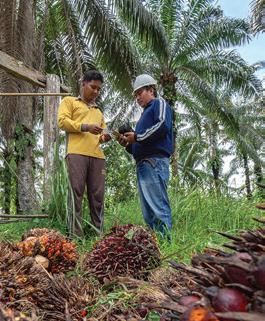
3 minute read
Scottish Government
years and examining them using scanning transmission X-ray microscopy at the CLS, Schaller and his colleagues were able to better understand how and why silicon and phosphorus bond to the soil.
The wide range of paddy soil gave Schaller’s team a precise look at how long it takes soil to be depleted of silicon and saturated with phosphorus.
Advertisement
“It’s really valuable (to be able to study so many samples),” said Schaller. “Rice cultivation, they’ve done it for a really long time…it’s really interesting, to use such samples.”
Because phosphorus is critical to the growth of rice and so many other crops, finding a more sustainable solution to promoting rice growth — like using cheaper and more available silicon-based fertilizers to prevent phosphorus saturation — is critical for the world’s food supply.
“This is really important for humankind,” Schaller said. “If we could decrease the need for phosphorus fertilization, this is a really important thing.”
Golden Agri-Resources introduces Sawit Terampil to enhance agricultural practices among farmers
Golden Agri-Resources (GAR) is collaborating with MARS and Fuji Oil to roll out Sawit Terampil, an upskilling programme for more than 4,000 independent smallholders from the Leuser Ecosystem area in Aceh and North Sumatera. It builds on GAR’s traceability efforts which has seen the company map 95 percent of its supply chain to the plantation. GAR is now looking to further improve the livelihoods of farmers identified through tracability to plantation efforts with Sawit Terampil.
The programme aims to provide comprehensive support to independent smallholders through group coaching and individual support to implement good agricultural practices. Capacity building trainings and mentoring will teach independent smallholders to improve their cultivation methods and prepare them to register for ISPO and RSPO certifications, which in turn will help increase their incomes.
“Upskilling farmers and suppliers with knowledge is key to implementing sustainable agriculture practices. Building on the information we gained through the traceability initiatives, we can analyse the potential gap in productivity, yield and agricultural practices and provide targeted assistance to smallholders,” said Anita Neville, Chief Sustainability & Communications Officer, Golden Agri-Resources.

Innovation in agriculture
By Rural Affairs Secretary Mairi Gougeon
I was delighted to attend Agriscot in November and meet so many people and exhibitors at what proved to be a very successful and well-attended event.
For me, a key part of the visit was announcing the nine businesses taking part in the latest round of the Monitor Farm Programme.
Run jointly by Quality Meat Scotland and AHDB Cereals and Oilseeds, the programme promotes sustainable innovation and transformational change in the agricultural sector.
It focusses on practical farming and good business practices to build resilient, dynamic farms focused on reaching full economic, social and environmental sustainability.
The long-running programme is backed by £1.7 million of Scottish Government funding and brings research and industry closer together to share bestpractice learning and experience across the agricultural sector.
It is ideally placed to support the wider agricultural sector to build resilience and optimise production, contributing to our food security while helping meet our climate change and net zero targets.
The fact is that innovation and sustainability has never been more important for an industry facing the significant challenges of the on-going war in Ukraine and against the backdrop of Covid-19, Brexit and the cost of living crisis.
As part of the process, each of the monitor farms will also have its own dedicated Management Team that will evaluate solutions and best practice before sharing its findings, both with the wider Community Groups and more generally through various media channels including a dedicated website.
I would encourage farmers and crofters to engage with the programme and benefit from the shared knowledge and experiences that come from the Monitor Farm Project.
The farms showcase the diversity of agricultural businesses and are located across Scotland – South Ayrshire, Strathspey, Banff and Buchan, Deeside, Stirlingshire, Roxburghshire, Dumfries, East Lothian and Argyll.
As it approaches its 20th anniversary, the Monitor Farm Programme continues to demonstrate its importance.
I am excited to see the range of ideas put into practice, tested and thoroughly evaluated and wish all the very best to those participating.










